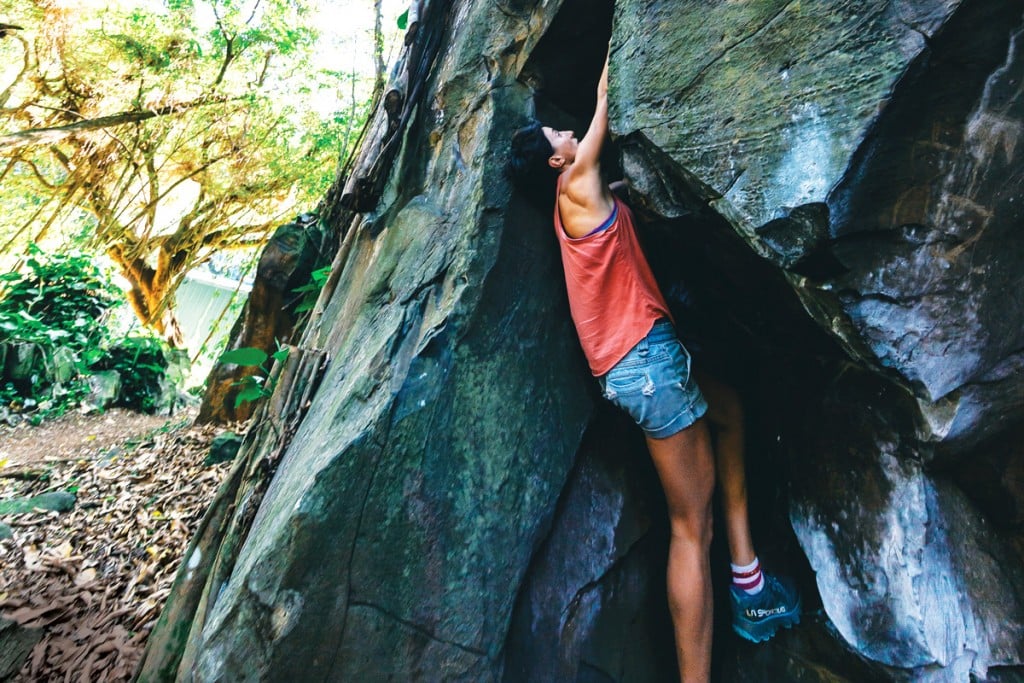
the Adventurous Sport of Bouldering
Share
Embrace Hawaii’s Rugged Outdoors with the Adventurous Sport of Bouldering
Climb nature's rawest obstacles with Hawaii's growing bouldering community.

My hands should be sweating, but they’re covered in white chalk, which keeps them dry. My focus is entirely set on not falling off this rock. I make the grab, swing my foot to an awkward slope and clamber my way up.
My ascent probably wasn’t pretty, but the view sure is. Looking down at Kapena Falls, one of Oahu’s many bouldering hot spots right up the road from downtown Honolulu, I see Justin Ridgely, owner and operator of Volcanic Rock Gym, and his ragtag group of friends and fellow rock climbers prepping 100 feet upstream from me for a new climb—a tall crag marked with white chalk. Ridgely calls this a “problem” and equates bouldering to a physical science: Learn the science and you solve the problem.
“It’s concentrated movements,” says 35–year-old Ridgely, bearded and in baggy joggers. An impressively cut physique matched with calloused hands, he looks exactly as you’d expect when you think of someone whose passion is to climb boulders. For those unfamiliar with the term, bouldering is a type of ropeless low-height climbing done on large natural boulders and, as Ridgely explains, focuses more on body positioning and calculated motions than brute force.
Catching up to Ridgely and his group, I watch a few members move their hands in midair, imagining how holds and grips will feel on this climb named Roots Route. “They’re sequencing,” says Vikki Glinskii, one of Ridgely’s friends whose muscular back and shoulders let on years of bouldering experience. She makes a move for the crag. It’s a V5, which is how the bouldering community denotes difficulty, with the range starting from V0 and going all the way up to V16. Ridgely has placed crash pads—large durable mats—beneath the climbers just in case someone falls.
“What do you have to look out for when bouldering outdoors?” I ask.
“Uneven surfaces, rocks and landings,” Ridgely says, “so having the safety gear is huge.”

Photo: Aaron Yoshino
With the appropriate equipment, bouldering in Hawaii is a perfect adventure. With most climbing spots being off the beaten path, a day of bouldering will typically include a hike, a workout and a view. “Whenever people come out here and ask me where they should go, I always say Waimea,” Ridgely says, referring to the rock wall on the side of the bay. “It’s the most accessible, has a parking lot and you’re on the beach. That spot is so much fun.”
Glinskii is looking good so far. Starting low in a shallow cave, she’s made her way up the climb to a tricky section. Out of reach from her next hold, she now has to perform a lunging jump. The team hollers words of encouragement at her and Ridgely has his arms outstretched in case she falls, being careful not to actually put his hands on her to help in any way. Glinskii lunges, reaching the hold but loses her grip. Now she’s falling.
My back hits the crash pad. I’ve tried this V3 climb in Ridgely’s indoor gym at least five times and I can’t seem to figure out the problem. At the Volcanic Rock Gym, climbers are encouraged to give it their all and challenge themselves, knowing that the gym’s floor is covered in padding. Falls still suck, but you’re not risking yourself over jutting rocks and hard surfaces. Located in Kailua, it’s a safe training space for Hawaii’s now-budding climbing community.

Photo: Aaron Yoshino
“It’s definitely grown dramatically the past eight years,” says Ridgely. “Our membership base has grown a lot more since we moved to Kailua.” And the gym serves as a great tool to introduce new climbers to bouldering and building core muscles and techniques used in the sport. “We’re trying to focus more on the training aspects; a lot of us now are looking at it like, ‘We want to get stronger.’ It gets very intense. We have pull-up boards, hang-boards and a TRX (Total Resistance eXercise) machine.”
Back at Kapena Falls, Ridgely grabs Glinskii middrop and directs her still airborne body to a crash pad. I can start breathing again. Almost immediately Glinskii starts talking with Ridgely about what went wrong and how she can improve on a second attempt.
The group takes a break and wayward tunes play out of a portable speaker. “Bouldering is definitely social; we’re chilling right now and someone could be climbing and we’ll still be talking to them,” Ridgely says to me as I take a seat. “If someone’s 70 feet up on a rope, we’ll be screaming at them.”
Ridgely’s on the climb now, working the same problem that bested Glinskii. It’s like watching a mathematician solve a difficult equation in physical form. Every movement is deliberate and well measured. The way Ridgely angles his body and grabs his holds are precise. The crew cheers him on as he reaches the top, proving to us all it can be done.
Volcanic Rock Gym
Open 3 to 10 p.m. Mondays through Fridays, noon to 8 p.m. Saturdays and Sundays. Volcanic Rock Gym, 201 Kapaa Quarry Pl., Building No. 25, Kailua, Oahu, (808) 397-0095, volcanicrockgym.com. More information on outdoor bouldering in Hawaii can be found at Ridgely’s website, hawaiibouldering.com.






















































